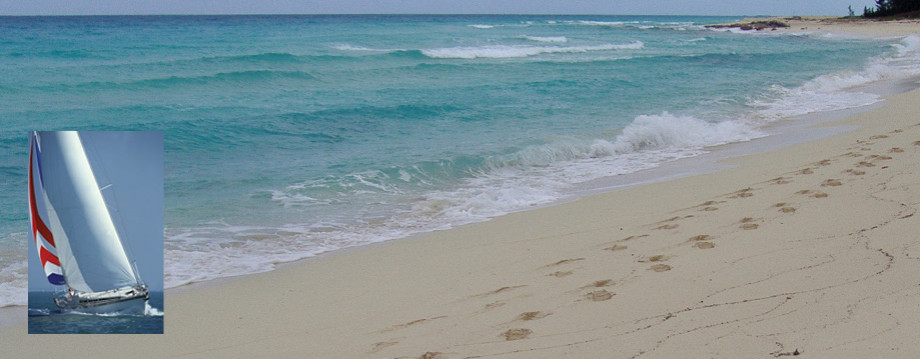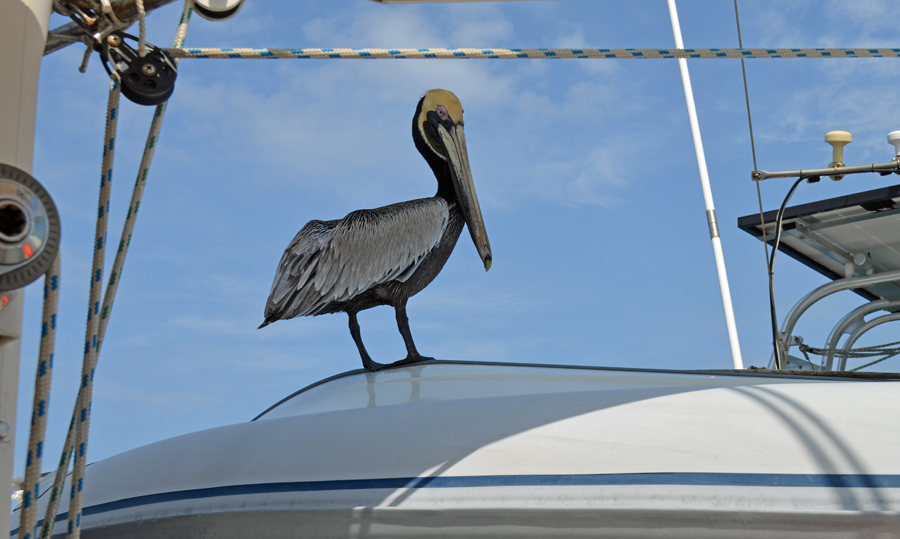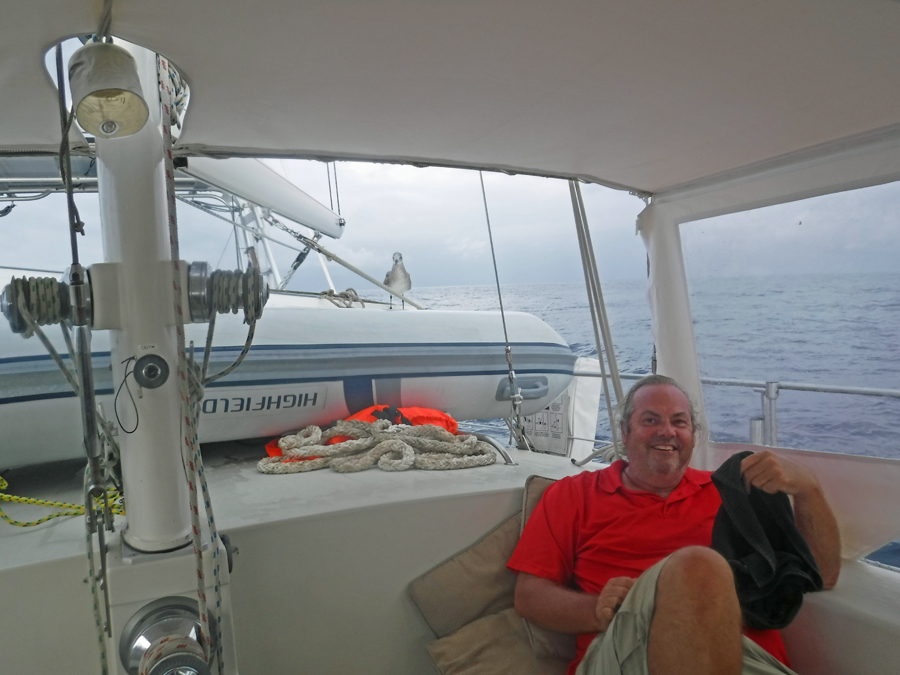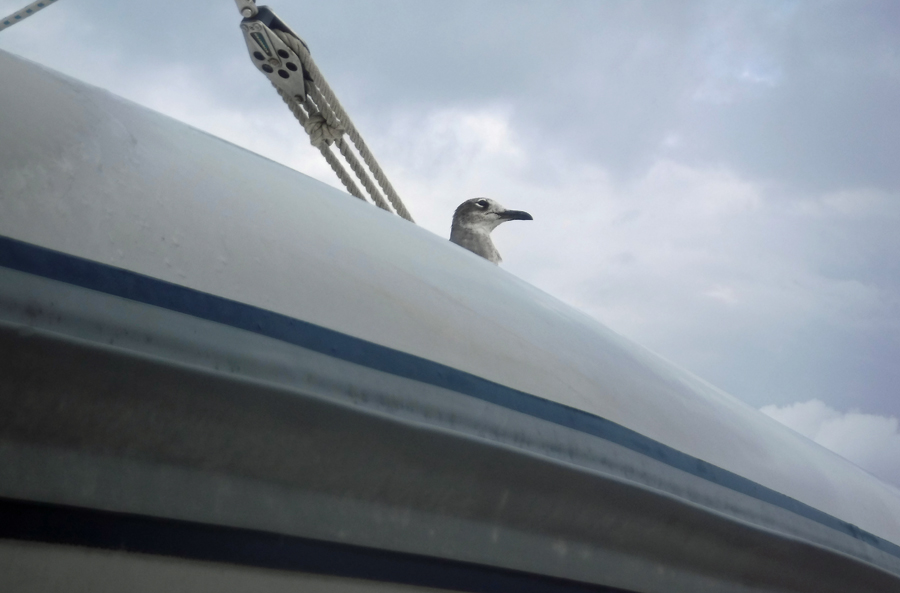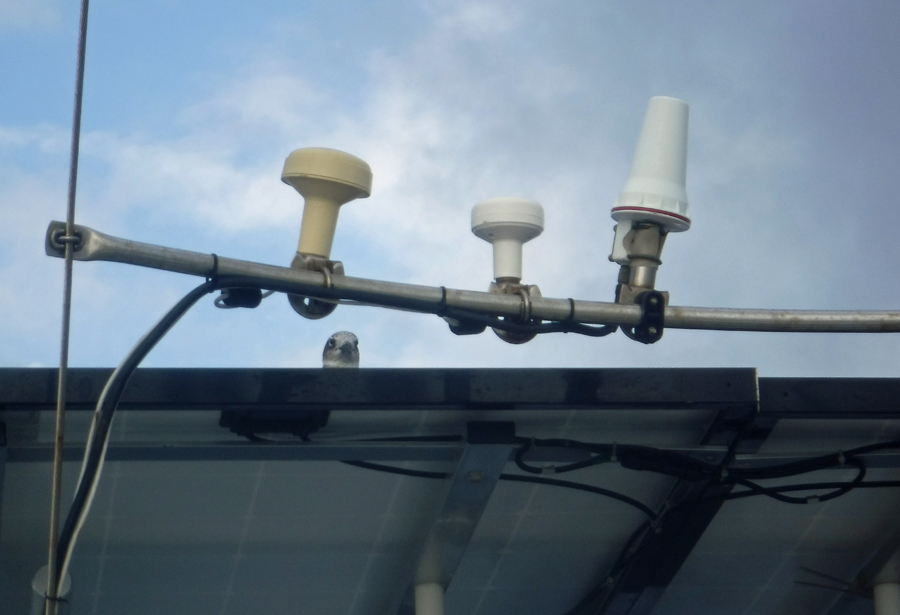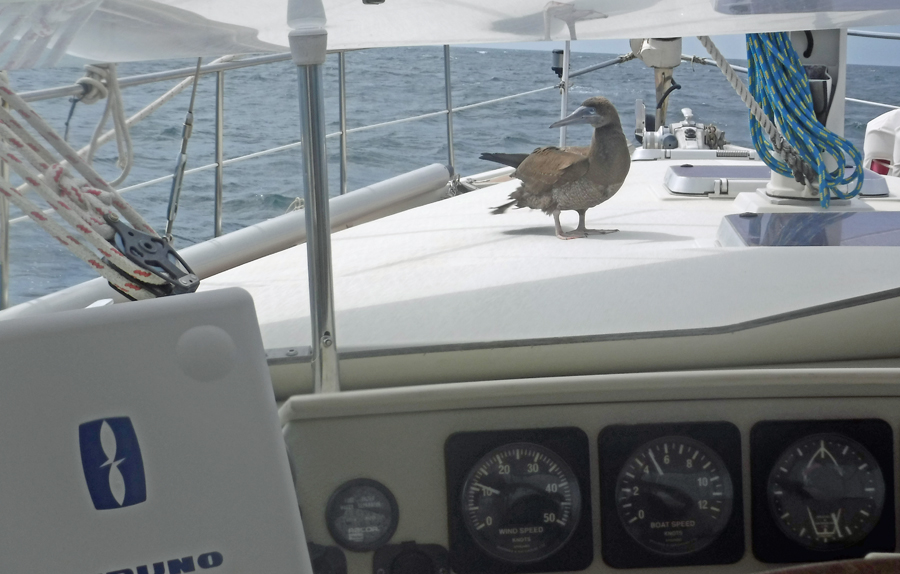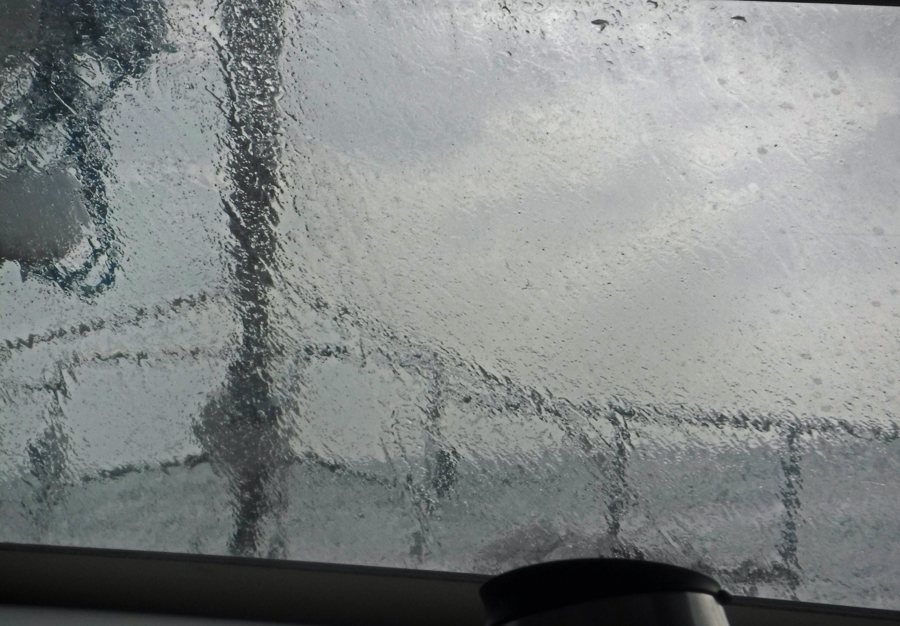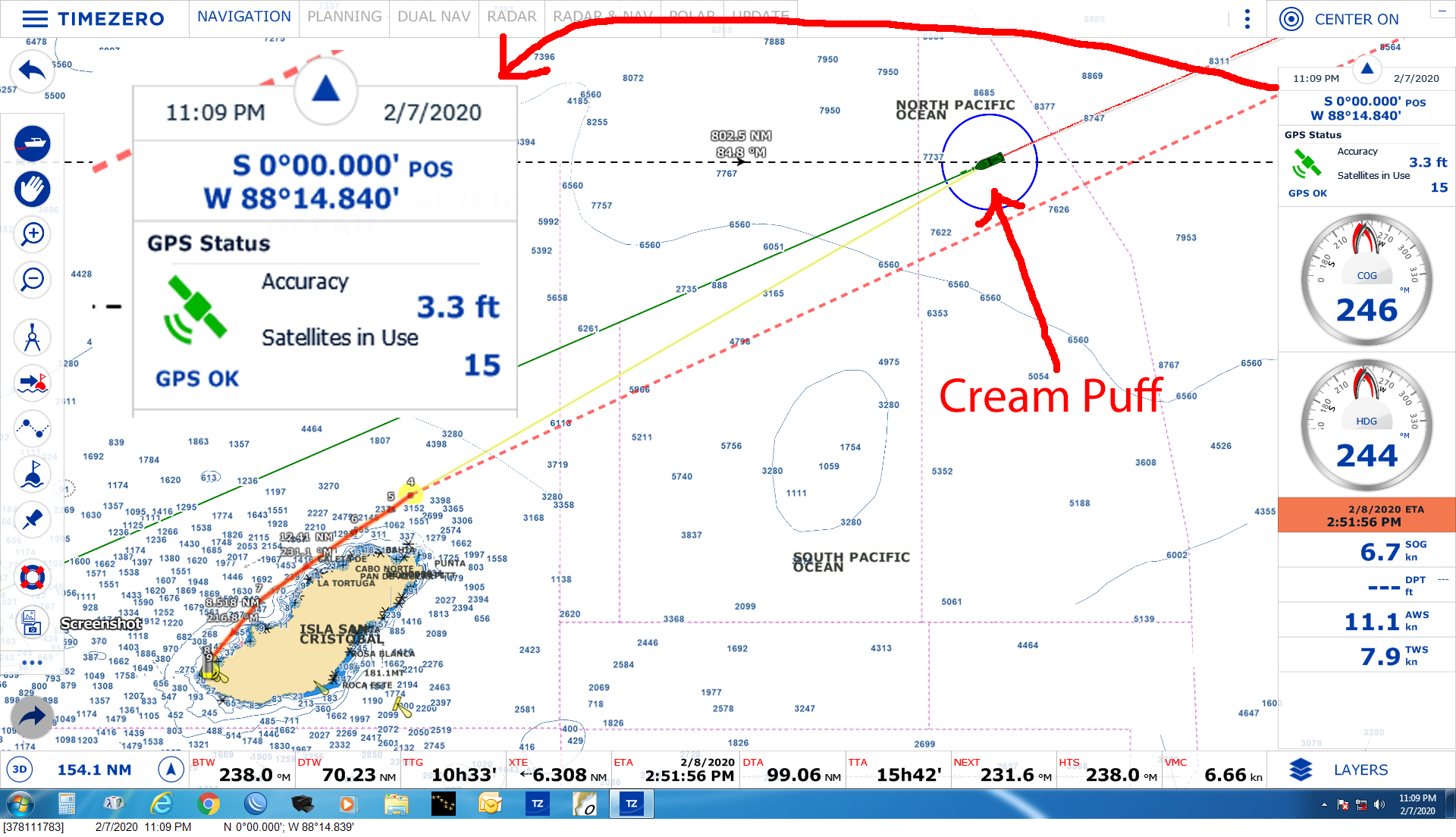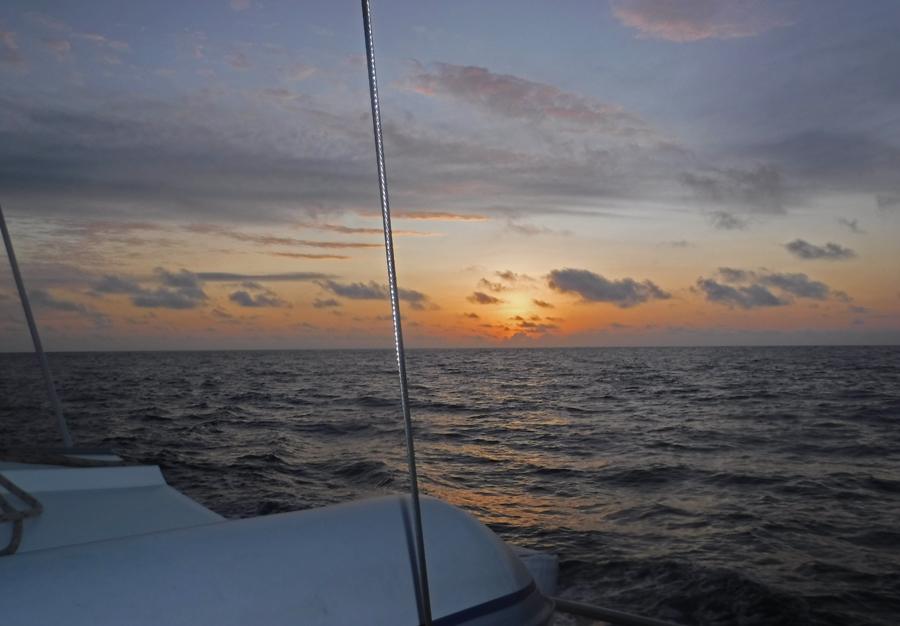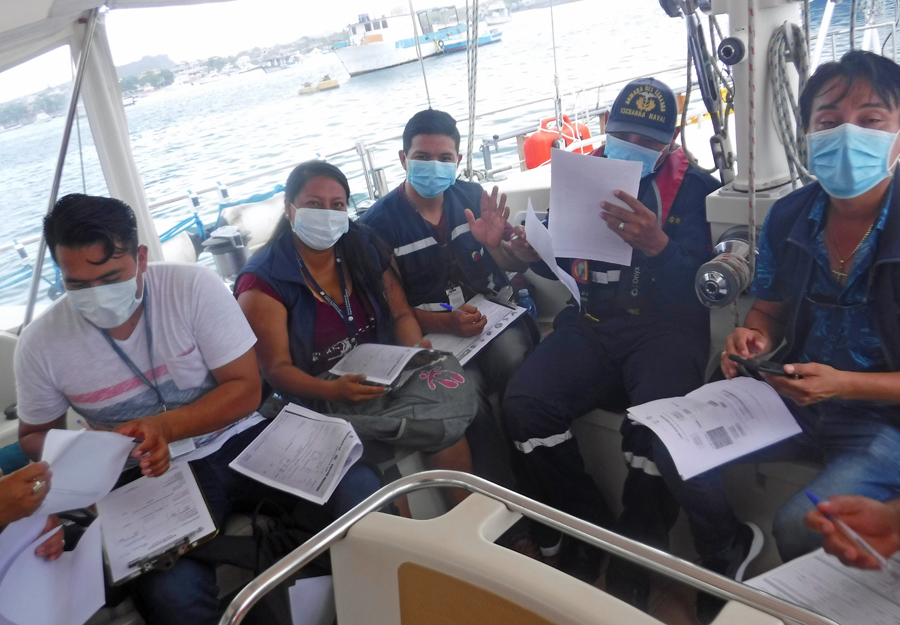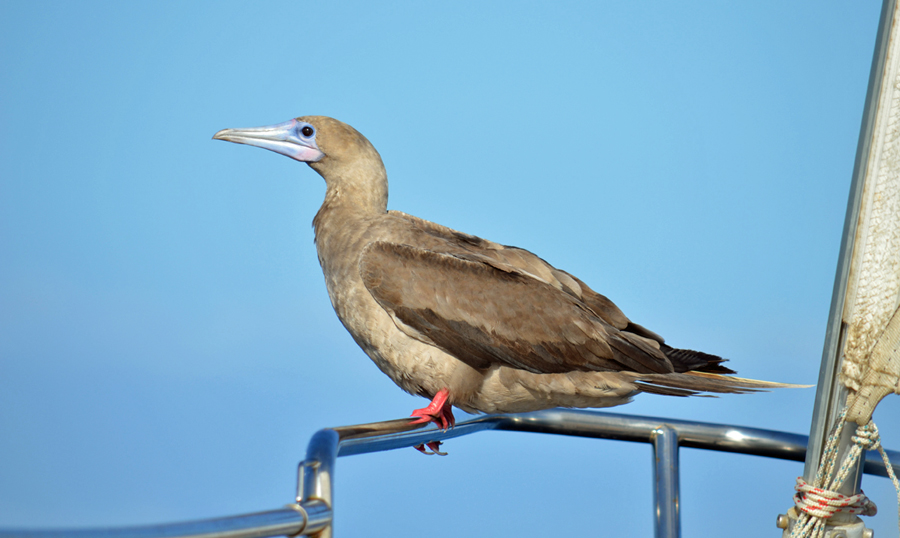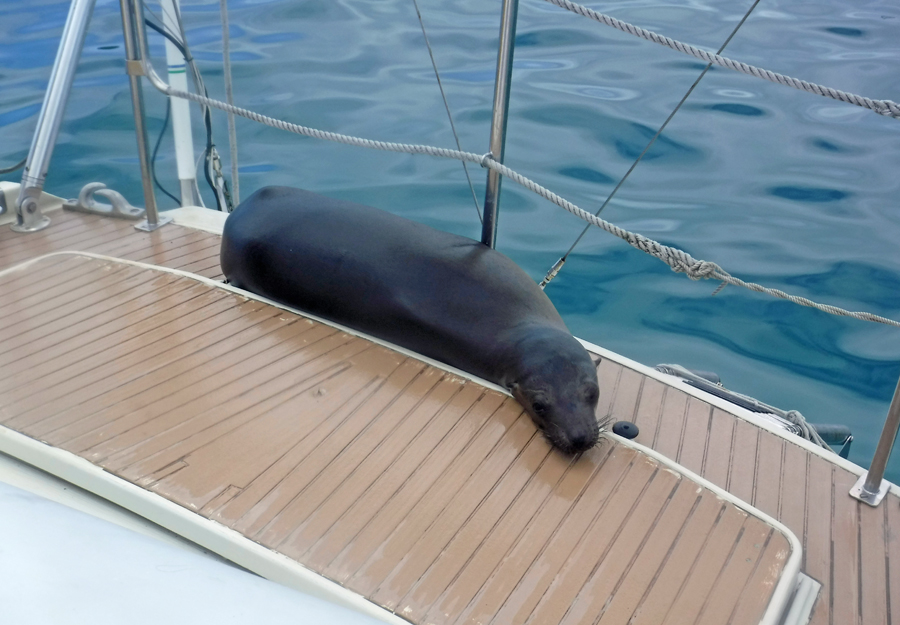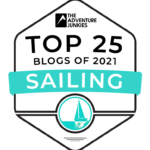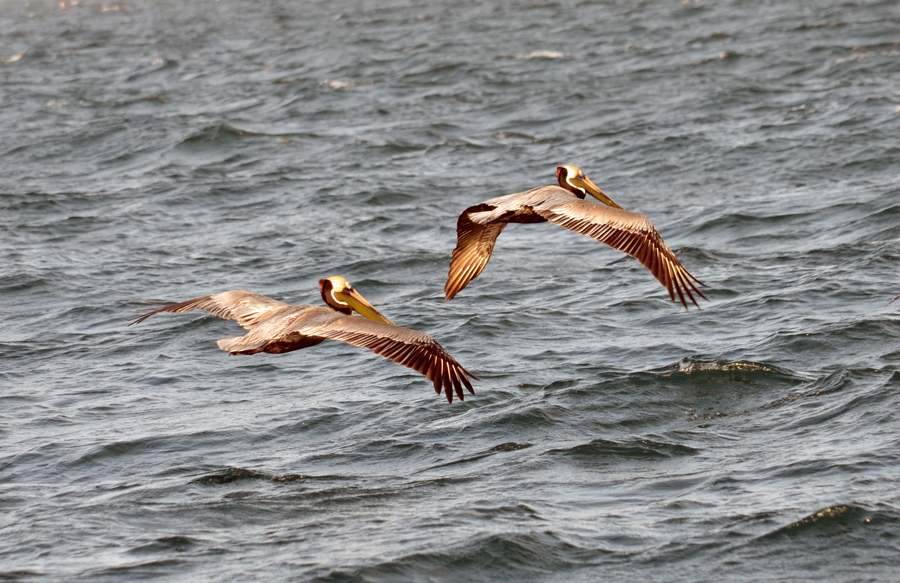
Cindy snapped this picture of two pelicans skimming the water in Las Perlas on the morning we departed Panama
Yea! We arrived safely in Galápagos.
The passage from Panama to Galápagos turned out to be one of the most challenging sails were have encountered so far in our wacky journey. The passage requires crossing an area called the Intertropical Convergence Zone (ITCZ). The area has doldrums and can produce spectacular thunderstorms. I hate lightning. The one thing I am deathly afraid of while on the water is lightning. In an instant, our vessel can be completely fried. My fear is amplified by the fact we have two huge metal rods pointing at the sky and are the tallest thing around for hundreds of miles.
To add to the joys of no wind and possible thunderstorms, the ITCZ can expand and contract and can even shift in position by a few hundred miles quite quickly. It is entirely possible for the zone to move in the same direction as a vessel making it that much harder to cross and escape the effects. This was something we monitored closely during our daily satellite weather updates. We have read many stories of yachts running seriously low on fuel trying to get to Galápagos.
Our plan for this passage was pretty simple. Wait for a strong band of wind crossing Panama from the Caribbean Sea and ride it for as far as we can to get toward the equator as quickly as possible. This places us south of the ITCZ and we have a good chance of picking up southerly trade winds for the ride westerly to Galápagos. The hope being the wind pushes us far enough south we would just have to motor two days through the doldrums of the ITCZ and then sail once we reach the southern trade winds. As usual, the plan looks good on paper but the weather had other ideas.
We literarily blew out of Panama. We waited in the Pearl Islands for the perfect weather window. This is an area of Panama about 50 miles south of the Panama Canal. The locals refer to these islands as Las Perlas. We used our time there to clean the bottom of Cream Puff and rid ourselves of barnacles (more on this later). We departed with winds of 25 knots often reaching 35 knots. This is not weather to take lightly. The wind on the hindquarter of the vessel is called a broad reach. Cream Puff loves sailing on a broad reach. Cream Puff also loves 25 knots of wind (29 mph, 46kph). She does a sort of happy dance in these winds. It wasn’t unusual to look at our speed over ground and see us traveling in excess of 10 knots (pretty fast for a sailboat). We had these conditions for two awesome days.
We usually function well in these types of conditions. Sleeping and eating can easily be accomplished on a broad reach since the pitching of the boat is minimal. It is a comfortable ride. But, ironically, the first two nights out on a long passage for us are the most challenging for us. We are often queasy and have difficulty sleeping. This is until we get into our offshore routine. Once in our routine, the queasiness goes away, we fall asleep faster, and our appetites pick up. So while we had the best sailing conditions, we both had the discomfort of “early passage blues”. This is when I learned something very interesting.
I love it when I learn something new. You can teach this old dog a new trick, or two. What I picked up on day one was something I have never read in any sailing books. Nor has it been mentioned in any blog or vlog I have viewed. It is not in Chapman Piloting & Seamanship. And I wonder if Sir Francis Chichester knew if this little gold nugget tip on sailing I am about to share. I think I might be about to enlighten you on something quite remarkable. This is a sailing tip you can take to the bank: Do not serve peas when underway.
Cindy made the most awesome shepherd’s pie. It is a recipe she found in a British cookbook over thirty years ago. It is one of the few recipes she made sure we had aboard when we set sail five years ago. One of the ingredients in shepherd’s pie is peas. Peas are round. Round things tend to roll. When we sat down to enjoy a healthy portion of the awesome pie, keeping the peas on the plate turns out to be almost impossible. Days later we are still finding peas in the crevices of the floor. If you plan to eat shepherd’s pie when underway on a sailboat, it is best to serve it in a bowl.
So here we are blasting along in double-digit speeds with our tummies happy. We are on the third day and celebrate the disappearance of early passage blues with sausage and egg breakfast tacos dressed with a dab of (Paul) Newman’s Own medium salsa. Yum! As expected, the wind started to die this day. Yep! We manage to find the ITCZ. Cranking up the motor, we expect to hear the drone of the diesel engine for the next 48 hours. Aiming for a waypoint on the chart plotter, this is where we expect to pick upwind. Rather than heading directly southwest toward Galápagos, we aim more south as this puts us out of the ITZC faster. We are halfway through the doldrums to our waypoint when we get a weather update. Yikes! Not what we wanted to see.
The latest weather shows the trade winds have pushed south and are almost nonexistent on our planned path. This means more motoring. But calculating the fuel, we do not have enough to motor the entire rest of the journey. We can get close but there are no fuel stations out in the ocean. Close isn’t good enough. Please do not let us be one of those boats who run out of fuel on the way to Galápagos. We need to make a decision. We can go our planned route but will most likely be sitting with no wind for at least three days hoping the weather changes or we can re-route and hope the weather doesn’t change and the new forecast is correct.
We decide to re-route. Using our TimeZero plotting software (it analyses the wind, currents, and waves and uses a performance matrix of our vessel’s sailing characteristics called a polar file) our computer suggests a more northerly passage keeping the equator well below us. This passage keeps us on the edge of the rain in the ITZC. It is a risk we are both willing to take. We alter course by about 90-degrees to follow the computer’s suggestion. We now aim slightly north of the islands. This turns out to be an awesome decision. We arrive one day earlier than planned and we have more than half of our fuel left. We decide to motor sail the last 24 hours since the computer shows absolutely no wind at all after this. And it was right on. Once we dropped anchor in Puerto Baquerizo Moreno on the island of San Cristobal the wind died for two days.
On the 7th of February, 2o2o at 11:09 pm (Panama Time – EST USA) Cream Puff crossed the equator and passed from the North Pacific Ocean into the South Pacific Ocean. This is undoubtedly a highlight of our cruising we will remember for years to come. I was asleep and Cindy woke me about 30 minutes ahead so we could watch our latitude count down to zero on the plotter, cross the equator, and then count upward. I managed to acquire a screenshot of the plotter at the exact moment we crossed. Since we never drink alcohol when underway, we put a bottle of champagne in the refrigerator for our arrival. We managed to make room in the fridge since we have been eating so well along the previous five days. When we left Panama, our two freezers and refrigerator were jammed full. Cindy plans well. She had a spot for the special bottle already prepared.
A lot of cruisers wonder if Galápagos is worth the hassle. To quote a sentence from Noonsite (the cruising sailor’s bible), “It might have been the French who invented bureaucracy but it was the Ecuadorians who have perfected it”. Entering Galápagos requires an agent. The agent coordinates all the necessary agencies required to bring a private vessel into this region of Ecuador. And, it is expensive! The price to have Cream Puff enter the Galápagos islands is about as much as it cost us to transit the Panama Canal. We are over two thousand dollars and we haven’t paid any local anchoring or zarpe fees yet. All the fees must be paid prior to arrival. Besides the steep price, the red tape is incredible.
Another cruiser posted on a FaceBook group page asking people who had been here if it was worth the effort. I loved one of the answers so much, I going to share it here. My favorite comment back to the lady was, “When I signed up for this cruising lifestyle, I didn’t sign up for just the easy islands or low-cost locations. I signed up to see the world and not sail past places because of inconvenience”. No, this wasn’t my comment. But, I do agree 100%.
I am not going to go into too much detail about the red-tape since you probably want me to keep this upbeat. However, there are a couple of things I shake my head about. First, where does all this money go? While here, we must sign multiple pieces of paper promising not to pump out black water (raw sewage). However, there is no service to pump out our holding tanks while in port, there is no pump-out station on any of the islands. The public facilities for us to use at the water taxi dock are really disgusting. I’m not exactly sure what the Ecuadorian government expects us to do when we need to poop. We do have holding tanks aboard Cream Puff and can hold black water until we are between islands. But, it would be nice to have other options for the amount of money we are paying.
A boat entering the Galápagos Islands must be free of any underwater growth on the hull, including slim and barnacles. They are deadly serious about this rule. Upon arrival, one of the many inspectors who board the vessel is a diver who certifies the bottom of our boat is barnacle free. If it is not barnacle free we would be told to leave, sail away 40 miles and clean the hull. Upon return, the hull would be inspected again. This seems to be only required for cruising yachts. Already, I have observed a multitude of tourist vessels arriving from Ecuador, supply ships and cruise (tourist) boats not being inspected by a diver and with obvious underside growth.
I hired a couple of guys to clean the bottom of Cream Puff’s hull while in the marina in Panama. This turned out to be a mistake. I explained to the diver how it was very important we need to be barnacle free per the Galápagos regulations. I further explained I was willing to pay for as long as the job took. When they did eventually show up they did a crappy job. While in Las Perlas waiting for our weather window, I checked their work. We have dive equipment and a compressor to fill tanks on Cream Puff. They missed about 50% of the boat and I spent most of our time in Las Perlas scraping growth of the underside. I blame myself here for not looking while in the marina. I was getting over a cold and didn’t really feel like getting under the boat. This is not my favorite thing to do. However, the one nice aspect of the job is it is cool in the water and I’m not sweating while I at it.
Another crazy piece of red tape is the zarpe process. A zarpe is a document usually issued when departing a country to prove to the next country the last port of call. In Galápagos, we must obtain a zarpe every time we move to another island. Of course, there is a fee for this. In addition to the local zarpe, we are required to have a national zarpe. I’m not sure why we need two zarpes. And of course, there is a fee for this too.
During our passage, we were told by our agent to check-in prior to leaving Panama, again when we were 48 hours away and once again when we had a firm ETA (usually the next day or same day). We needed to be able to send email while underway which is not a problem for us. We can use our inReach or satellite phone for this. For some lower budget cruisers, this might be an issue. However, if they are lower budget, they probably would stop here anyway. This messaging is done so the arriving vessel can be inspected “immediately” upon arriving. Within an hour of arriving, we promptly received 8 inspectors all at once. They included customs, immigration, the diver, the health department, the navy and a couple of others who I am still not sure what they inspected.
Our agent translated for us which mostly meant she said, “Sign this”. I am going to give the inspectors a huge compliment. They were courteous, friendly and smiling. They laughed and we all joked as we filled out the massive amount of paperwork. This made the check-in process enjoyable. Our agent had prepared documents ahead of time to speed up the process. She already had papers Cindy had previously sent from Panama such as the Panama exit zarpe, copies of passports, ship’s papers, insurance etc. She handed copies to the appropriate officials.
There was one request that was a bit of a shocker, proof of a yellow fever vaccination. We knew we would need this since we have visited high-risk countries. In Aruba, we took the time to get the required vaccinations. Cindy does a great job of reading up on the requirements for us down the road. When entering Panama, this vaccination was a requirement since we arrived from Colombia. However, nobody asked for proof. Out of curiosity, I asked the Galápagos agent what would happen if we could not produce the yellow fever vaccination. The answer was entry would be denied. Yikes!
It seems like Cream Puff has turned into a regular Noah’s Ark since departing Panama. We enjoyed seeing all sorts of avian hitchhikers tag along for a free ride. My favorite was a red-footed booby who made itself comfortable on the bow railing for a couple of days. It squawked loudly at any other bird who came near protecting its perch with vigor. It even woke me up a couple of times squawking. It took off for food periodically but returned and pruned after each venture. We pick up this booby about 300 miles west of Panama and carried it for at least 300 miles toward Galápagos.
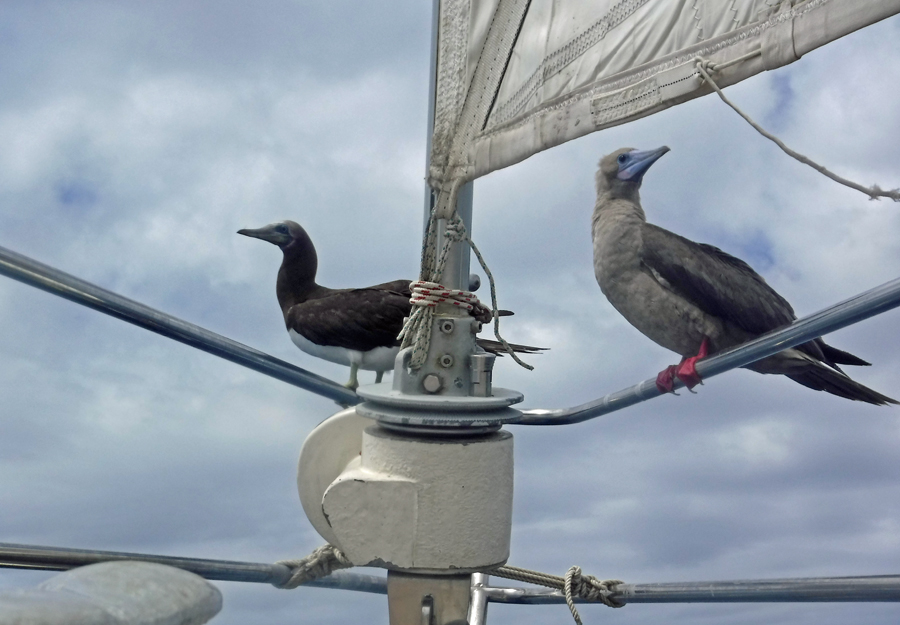
After a lot of squawking and flapping, the red-footed booby makes way for a brown-footed booby on our bow railing.
We had a big laugh once we got Cream Puff’s anchor down in Puerto Baquerizo Moreno on the island of San Cristobal. We were previously warned about seals getting on boats. The seals love sugar scoop transoms (steps built into the back of the boat). No sooner than we connected the anchor snubber and had our traditional PDA on the bow we turned to return to the cockpit. We hadn’t been anchored for more than 5 minutes and we already had our first visitor. Sprawled out on the stern of Cream Puff was a seal looking at us with those ever so cute dark watery eyes, “I am so very cute, aren’t I? Please don’t make me move”. After our clearance with the inspectors, we spent the next few hours trying to “seal proof” our boat. To quote Cindy, it seems as though the seals have a lot more experience getting on people’s boats than we have keeping them off. So far, the seals are winning.
